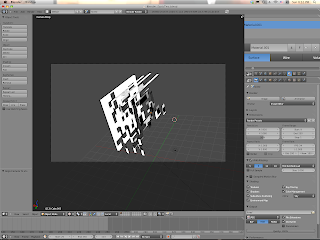D U E
August 1 :
Reading (The New Aesthetic)
and selection of Tumblr post/reasoning
as a post to your class blog.
August 5 (EDITED) :
Project 5!
In addition, comments for peers
not already posted to their blogs.
Projects 1, 2, 3, and 4. I will finally
be able to check for those.
★ ★ ★ ★
P R O J E C T 5
Geometric Portrait, Using 3D Modeling
"Learning About Blender 3D and Self"
Blender 3D is a freeware program! Downloadable from the official site, for PC or Mac. Heavily encouraged is a three button mouse (left button, right button, middle wheel) to help you out. Lab has plenty already connected to monitors.
*Now the "3D World". With Blender 3D, we will be employing a technique called "box modeling". In laymen's terms, a very lo-res method of 3D modeling that is typically a precursor to a more defined model. However for our purposes and parallel to the ideas from "The New Aesthetic", we are going to be chivalrous to the concept of 'cubes' and 'minimalism'.
Workflow of Project 5
1.) Explore the fundamentals of Blender 3D (program)! A tutorial post I've written containing everything necessary to completing assignment follows this one.
For the record, the version of Blender I have employed for the write-up is 2.56. Fundamentals may apply if a different version, but be sure. Working computers in lab should have Blender installed.
2.) With techniques and fundamentals in mind, develop project. You are to create a self portrait. Additionally, a portrait of yourself you believe would be perceived from the lens of a machine. Geometric in nature. This is where the cubist visual-minimalism comes in handy for the college student without enough time to create a million-polygon rendition. You may be very, very liberal in your approach to your machine-esque self portrait. It may be your head or face. It may be a certain character or closely related object to you which summarizes your being. But it is self portrait. In your statement, think hard about why it relates to you.
3.) The method of turn-in : Five snapshots rendered from Blender and posted to your blog. This way : One front-view, one back-view, one-side view, one-top view, and angle of your choice. Also, of course, the artist's statement.
Silly example...
This is just an example I did (playing with the whole 'other things are me' schtick) inspired by Michael Murphy's work. I took a zoomed up pixel shot of Sonic from 1991, even further bitmapped it to look more primitive, and distorted the individual pixels by deleting 'polygons' from panels it mapped the image onto.
A less silly example...
This is actually refuse of a current project I am working on, where I consider a 'fictional' game character to be a self portrait of me, through the narrative. In a way, I consider old videogames to be 'story generating devices', because the old 8/16 bit characters don't have a deep mythos to them. I am left to insert my own emotions.
A good page to see geometric "self-portraits"-
The Polygon (tech website) 'about us' page. Full of staff, 'derezzed'-
Links for inspiration-
It is easy to be discouraged at first. That is why you have extended time than usual to practice. Start slow. Build up. Don't expedite any steps that seem important.
Once you realize 'modeling' is nothing but moving, rotating, and scaling a series of bent boxes, the fundamentals take on more complex and understandable forms naturally.
.











No comments:
Post a Comment